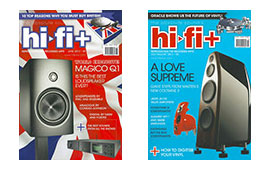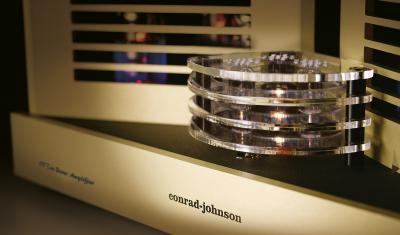conrad-johnson ARTsa STEREO POWER AMPLIFIER
After the successful launch at the CES this January, conrad-johnson's new stereo flagship amplifier - ARTsa, started shipping only a few days ago. Experience and history taught us many times that less can indeed be more. Or, at the very worst, as much as what "more" was. in this context, "more" means no less than already very much acclaimed and established ART mono power amplifier.
The new conrad-johnson ARTsa is a stereo chassis developing seriously good sounding 140W per channel and costing in the United Kingdom £17,995 inclusive of VAT. All the usual trademarks of CJD craftsmanship and refinements are very much present within the ARTsa. We should also remember that the available power of "just" 140W per channel is more than sufficient for the vast majority of world's leading loudspeaker designs, irrespective of design principle, level of efficiency or any other specificity in question.
We expect to have first ARTsa amplifiers in the UK well before the end of August and hope this significantly less expensive, practically more usable and variant of the ART monoblocks will find a few discerned (audio) homes here before too long.
NUMBERS GAME (OR GAMES WITH NUMBERS?)
For some time we have been following the, somewhat typical and predictable, trends of development related to d/a processors associated with computers and corresponding audio files. As common sense and a bit of basic wisdom would imply, it did not take long for a number of manufacturers to start bombarding consumers with their specification sheets and, in particular, certain parameters therein. One immediately draws attention - the "almost mandatory" (not really, as we shall see very soon) presence of the 24-bit/192kHz ability among the available resolution levels. As UK distributors of fairly respected and acclaimed HRT products (which, incidentally, do NOT offer any 'numbers' higher than 24-bit/96kHz) we are, of course, keen to learn and interested to know why is the presence of 24/192 option suddenly of such relevance when there is so little genuinely encoded (recorded) music material of the kind available for anyone to enjoy (irrelevant minute labels and/or insignificant and unknown performers/artists excepted)???? In our conversations on the subject with the general public, two "explanations" usually offer themselves for consideration: a) the higher the bit rate and sampling frequency, the better (?????) and, b) oh, well, so-and-so label offers 24/192 files for download.
First one is easy to understand as it underlines a simple human gullibility emanating from the old days of Japanese product spec sheets - some numbers needed to be either as high or as low as possible for the product to be declared 'superb". However, allowing for a moment of true brainwork will tell us it does not really work like that. If, indeed, the world was overcrowded with genuine 24/192 recordings from major labels and artists available for download to the general public, YES! we would definitely need hardware resolving them appropriately (and I promise by the time this capital prerequisite has been met, there WILL be many more of those doing it).
Some of those we talked to believe that, with 24/96 and 24/192 resolution available on DACs, they could copy (rip) their CDs or other disc mediums at a higher degree of quality (than the "original"). Well, that would be nice, but how can you convert something originally encoded at 16-bit/44.1kHz, into a better sounding and result by expanding NON EXISTENT data/musical information!? Something out of nothing does not happen, right?
The very best example of the above is the currently fashionable trend to "rejuvenate" old music (recordings) to the 24/96 or higher resolution levels and, of course, sell this to the general public at an interestingly high cost. Not sure what this may be about either, but if someone wishes to listen to the originally (at the time of recording) introduced distortion or tape hiss at the highest possible bit rate and sampling frequency, by all means!! We will, in the meantime, do the best we can with 16/44 resolution levels when replaying our CDs as high-resolution computer audio files and stretch the envelope to 24/96 ONLY when we choose to encode (make a "recording") an ANALOGUE source (LP, radio broadcast, live performance, etc.) material into a high-resolution computer audio file (AIFF, FLAC, WAV).
Cynics will say pretty quickly the only reason for this musing is because we do not have any DAC or ADC hardware capable of more than 24/96 resolution. Could be so, but it is not. All we wish to achieve is to entice people to think and, think for themselves. There is no question that, given time, 24/192 (or even higher than that) will become a norm and most (if not all) music will be available recorded at such a great level of resolution and sounding much better than anything we have today. Until then, a bit of common sense and less obsession with numbers, please.
AUDIOFREAKS PRODUCTS IN THE AUDIO PRESS
 Not much to report this month, but we did have a few nice mentions in the UK audio press since the last News Page. Hi-Fi+ Editor Alan Sircom published a most interesting piece on ins and outs on creation of analogue-to-digital computer audio files. In that context our HRT Line Streamer+ could not be bypassed as it is one of the very few (and certainly among the most inexpensive) available products of the kind. Also, Jimmy Hughes reviewed the Magnum Dynalab MD801 Internet Media Tuner in the August 2012 issue and, in his most enjoyable and inimitable approach, provided a very good insight into the virtues of this product. Finally, Roy Gregory undertook a major task of presenting how a fundamental design of one single product (conrad-johnson TEA-2 phono preamplifier) can be elevated to a number of different levels of performance and cost while clearly justifying and rewarding each of those in an honest and impressive manner. This is RG at his best, so have a look into the July 2012 issue of Hi-Fi+ if you are intrigued...
Not much to report this month, but we did have a few nice mentions in the UK audio press since the last News Page. Hi-Fi+ Editor Alan Sircom published a most interesting piece on ins and outs on creation of analogue-to-digital computer audio files. In that context our HRT Line Streamer+ could not be bypassed as it is one of the very few (and certainly among the most inexpensive) available products of the kind. Also, Jimmy Hughes reviewed the Magnum Dynalab MD801 Internet Media Tuner in the August 2012 issue and, in his most enjoyable and inimitable approach, provided a very good insight into the virtues of this product. Finally, Roy Gregory undertook a major task of presenting how a fundamental design of one single product (conrad-johnson TEA-2 phono preamplifier) can be elevated to a number of different levels of performance and cost while clearly justifying and rewarding each of those in an honest and impressive manner. This is RG at his best, so have a look into the July 2012 issue of Hi-Fi+ if you are intrigued...

